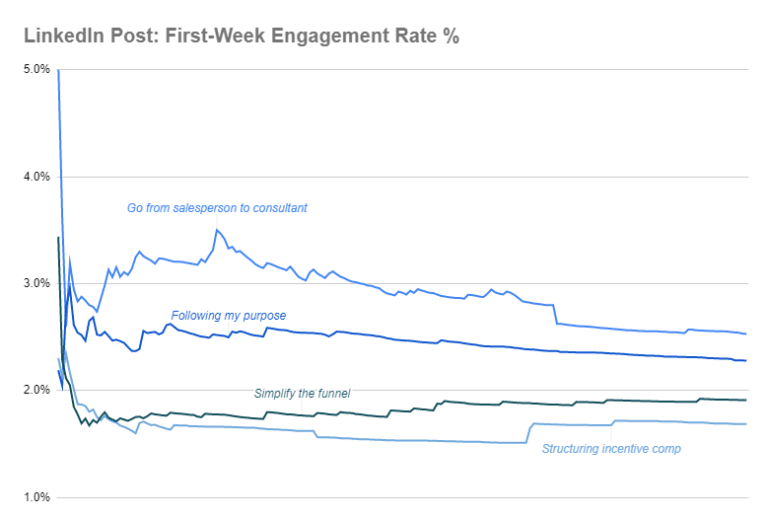Most people think of “sales” as sales.
It’s one role.
What else could there be?
You hire a salesperson, and they bring in new subscriptions and contracts with new business clients. In the middle, there are probably a lot of activities going on: networking, phone calls (and maybe some of those are cold), maybe you have a marketing team doing some advertising, proposals, some time “wasted” on social media, and a grab bag of other things. B2B lead generation is so much more exciting than that.
You’re not really sure exactly what those activities are, the breakdown of time spent on each one, or the value of each different tactic. But you know each salesperson has a quota, and you know you can measure the amount they bring in vs. how much they cost to the company.
There’s a better way to frame this.
While there is an art to selling and marketing, when you’re starting out with building a B2B lead generation program, you’re better off thinking of it as a science, as an equation to be solved.
In this article, we’ll talk about what lead generation is, how it’s unique within B2B, how to think about where it fits within your sales and marketing strategy, and we’ll also give you a few ideas to start with.
What is B2B Lead Generation?
B2B lead generation is the practice of identifying and attracting ideal customers for your B2B product or service.
B2B lead generation involves inbound and outbound strategies designed to help you build visibility, awareness, and interest. And because you’re targeting a particular audience type, your strategies must be designed to only appeal to that specific target audience.
As you can see, effective B2B lead generation campaigns require strategic planning and thorough research, especially concerning product/market fit.
How Does B2B Lead Gen Differ From B2C?
If you’re reading this, chances are you already know what B2B is and that your company is a B2B organization. B2B stands for “business to business,” which means you don’t sell to consumers. You sell to companies. If you sell to consumers, your company is a B2C organization.
While the acronyms are simple, there are a few other things to understand that separate B2B lead generation from B2C lead generation in some fundamental ways:
People Are Still People
They don’t become emotionless robots as soon as they are working with you in their capacity as professionals. For example, a Director of Marketing purchasing marketing automation tools also buys cars and homes. Like everyone else, they also have a sense of humor and probably an Instagram account.
Don’t forget to remain a human when you’re selling and marketing to businesses because a “lead” is a “person who happens to control some budget, who is interested in working with you.” Too many people lose sight of this and assume they’re talking to a procurement checklist. What does this mean? For example: take the bullet points out of your cold emails and tell stories instead.
The Opportunity Landscape Changes Dramatically
Strategies you can’t get away with when you’re marketing to consumers in their capacity as individuals now become viable because your value per lead in B2B is much higher than in B2C. That’s why companies selling to enterprises are often willing to pay thousands of dollars in total costs for a meeting with a Fortune 2000 decision-maker because the expected payoff is huge.
Meanwhile, a consumer-focused company getting a lead to put their @gmail.com address on their mailing list isn’t worth anything near that. People acting in their capacity as professionals have many different ideas about value and about what’s expensive or affordable.
Long story short: remain human, recognize that you’re interacting with emotional beings who nevertheless are wearing their “I’m at work” hat, and recognize the enormous value of a B2B lead. Finally, when you’re reading about lead generation tactics, make sure that the first thing you understand is whether you’re getting B2C or B2B advice because that’s the most fundamental perspective to adopt when you’re building up a lead gen program.
MQLs Vs. SQLs — Key to Effective Lead Generation
When running a B2B lead generation campaign, there are two main types of leads you must focus on MQLs and SQLs. Focusing on these helps ensure that your efforts result in increased revenue.
So, what are MQLs and SQLs, and what role do they play in designing an effective B2B lead generation strategy?
Marketing Qualified Leads (MQLs)
An MQL is a lead that fits your ideal customer profile (ICP). They look like a promising potential customer on paper and have shown interest by interacting with your content or marketing team.
Despite showing interest, they haven’t entered your sales funnel yet as they’re still on the “Evaluation Stage” of your buyer’s journey. MQLs are solution-aware and on their way to becoming product-aware. MQLs are best left to the marketing department to work on them until they’re ready to talk to sales.
Defining what qualifies as an MQL for your brand is important as it helps you:
- Focus your efforts on leads that are more likely to convert.
- Speeds up the process of moving them along your funnel.
- Helps improve the targeting for your marketing efforts.
- Helps you refine and personalize your lead nurturing process.
To run an effective B2B lead generation campaign, you must have a clear definition of what your MQLs look like.
Sales Qualified Leads (SQLs)
SQLs are leads your sales team qualify as potential customers. These should be moved to your sales funnel and handed to your sales team to nurture them to the finish line.
SQLs are closer to turning into closed deals as they are solution aware and are looking to make a purchase. All they need is the right content to convince them that you have what they need. This is where your sales team should have sales-focused content designed to answer any reservations they may have about getting your product.
Defining and identifying your SQLs is an essential aspect of running an effective lead generation campaign as it:
- Improves your team’s efficiency.
- Results in more deals being closed.
- Improves the quality of your customer base, resulting in increased customer retention rates.
Sending leads to sales prematurely can result in wasted time and resources. That’s why you must ensure you determine the criteria that make for an SQL in your organization.
Defining your MQLs and SQLs will help ensure your lead generation efforts pay off. It also helps create stronger teams that work better together to grow your business and revenue.
How Much is a Lead Worth to You?
Corporate leads are worth a lot more than individual leads. But how do you calculate how much each lead is worth? It’s important to know this so you can figure out how much you’re willing to spend on lead generation.
Here’s one equation you can use to calculate this:
[Lead to Opportunity Conversion Rate %] x
[Opportunity Win Rate %] x
[Average Deal Value $] = Lead Value
I’m defining an “Opportunity” as a sales opportunity within a qualified account that you believe has a good chance of becoming a client of yours. Your ‘win rate’ is the percentage of these opportunities that convert into paying customers.
Average Deal Value is a little trickier. You can think of this as the annual revenue per customer, the lifetime gross profit (revenue less cost of sales) per customer, or some combination thereof. We suggest you think of your average deal value as either the first-year or lifetime gross profit you can expect from your typical customer.
If you’re a software company with a huge customer lifespan – several years, let’s say – you may end up over-spending on lead generation if you assume several years of revenue per customer. However, if you’re a B2B services company with an average contract size of $5,000, but your typical customer orders from you 3X over the course of their first year doing business with you, then you’re better off thinking of your average deal value as $15k, rather than $5k.
Let’s plug some numbers in here, to do an example:
Lead to Opportunity conversion rate = 50%
Opportunity win rate = 25%
Average deal value = $40k
Value per lead = 50% x 25% x $40k = $5k
Now, you know how much each lead is worth to you. You shouldn’t spend that whole $5k to acquire that lead, or you wouldn’t be making any money – you should spend anywhere from $600 – $1200 to acquire each lead so that you have profit left over.
What this means is, when you’re thinking about different lead generation strategies, you should be highly suspicious of any type of tactic that seems to offer leads for $10 – $80 apiece. Something is wrong with this, or they’re using a wildly different definition of “lead” than you are. Similarly, you shouldn’t invest in programs that result in a $2000 – $3000 cost per lead because you know your efficiency will be too low since you’ll be spending an overly-large chunk of your profits on marketing.
12 Effective Lead Generation Strategies To Learn From
Everyone has a slightly different definition of a “lead”. But one easy way to think of it is someone who has raised their hand and indicated they’re interested in talking to you about what your company could do for them.
Because B2B leads are valuable, you’re almost always going to want to speak to them before they do business with you. The large majority of B2B organizations we work with don’t even make it possible to sign up for their product until conversations have been had, and a customized agreement has been signed.
With such a high value per sale, you’re better off speaking to prospects and building meaningful relationships. Even before you’re 100% sure they’re “qualified” to do business with you.
That’s why a “lead” is someone who works at a company that seems to fit reasonably well with your target customer, seems to understand what it is you do, and has indicated somehow that they’d like to directly learn more from you about whether there’s a fit.
This leaves us with a world of possibilities for how your target customers can learn about what you do and also for the various ways they can tell you they’re interested. One of the broadest classifications of lead generation you’ll come across in B2B is the choice of Inbound or Outbound.
Think of Inbound Lead Generation as “luring” leads and Outbound Lead Generation as “hunting” leads.
Examples of Inbound Lead Generation
Need examples of some inbound lead generation strategies you can implement?
Here are our top seven inbound lead generation strategies:
1. Content Marketing
Create great, personalized content and promote it where your target audience hangs out. If your content is valuable and answers some of their pressing questions, they’re more likely to give you their contact details for more content. They may not ask to talk with you right away, but the idea is that they eventually will.
No matter your niche, industry, or the size of your business, you need to leverage content marketing to generate leads.
2. Invest in SEO
Search engine optimization (SEO) involves creating content that gets picked up by search engines. This content is deemed valuable to users as it meets search intent and is well-formatted to provide a positive user experience (UX). Creating content that ranks is essential as most B2B buyers start their search for solutions online. In addition, being visible online results in more leads coming your way. And that’s why you must design an effective B2B SEO strategy for your brand.
3. Build Thought Leadership on LinkedIn
Developing a B2B LinkedIn marketing strategy is another excellent way to drive leads to your business. Create industry-specific content and post regularly on your LinkedIn profile. Leverage relevant hashtags and tag strategic connections to gain more visibility and spark conversations. Do this strategically, and you’ll soon establish yourself as a thought leader people will reach out to for help.
4. Event Sponsorships
Sponsoring online and offline events is another excellent B2B lead generation strategy. For one, it helps you boost your brand awareness. Secondly, it helps you reach an audience that fits your ICP. Whether the event is online or offline, ensure to have a way for attendees to submit their details easily.
Sponsorship deals are a great idea as you can offer the host usage of your solution if possible. Otherwise, you can help fund the event or giveaway your product as a prize for event competitions.
5. Leverage Ads
Ads have always been a great way of attracting leads. Again, these can be physical ads like out-of-home (OOH) advertising or digital ads. The key is to target heavily-trafficked channels.
6. Give Away a Free Tool
People love tools that make it easier for them to achieve a goal. Building a tool that you give away in exchange for contact information is a surefire way to drive relevant leads to your business. The tool doesn’t have to be complicated, it just needs to solve a problem for your target audience.
7. Create a Referral Program
Referral programs are a great way of mobilizing your customers into a marketing army. By offering your customers an incentive for referrals, you increase the chances of getting better-quality leads. One of the best parts of referral marketing is that you can automate the process. As a result, you lower your customer acquisition costs (CAC) and ensure a steady stream of qualified leads.
B2B inbound lead generation strategies take time to bear fruit. But when they do, you can be assured of high-quality leads.
Examples of Outbound Lead Generation
What outbound B2B lead generation strategies should you employ?
Here are some examples to help you get started with yours:
8. Cold Calling
Cold calling may be one of the oldest outbound lead generation tactics, but it still works. One reason for this is the human touch. Find the phone numbers of target customers, call them, and set up product demo appointments.
9. Cold Emailing
Like cold calling, cold emailing involves finding your prospect’s email address, sending them personalized content. To be effective, your email must highlight specific pain points and how your product can help solve them. Make sure to include a link to your calendar to make it easier for prospects to book a meeting with you.
10. Use Direct Mail
Send hand-written letters to prospects to initiate a relationship. You could do this by sending a gift card (everyone appreciates a Starbucks gift card, after all). Make sure to include your business card with the gift card. A good tip is to follow up with an email asking if they got your coffee. Your email should also reaffirm your value proposition and offer an opportunity to meet and go over suggestions you have for improving their business.
11. LinkedIn Outreach
For B2B brands, no other social channel is as powerful as LinkedIn. That’s why you must develop and run a LinkedIn outreach strategy to generate leads. One way of doing this is connecting with decision-makers who work for brands that fit your ICP. Send a short message introducing yourself and what your brand does. You can also reach out to connections that engage with your content.
12. Fish in Communities
Communities are another excellent place to find high-quality leads. Join relevant communities and forums and use them to look for prospects. Don’t sell your product outrightly, as this can get you banned or make you appear spammy. Instead, offer value and help whenever you can. Doing this will help you gain trust and respect in the community. As a result, when you pitch your product or services, community members are more likely to pay attention when you pitch your product or services.
One of the most significant advantages of outbound lead generation is that you get results faster. However, this is only if you do it right.
Prioritizing Lead Gen Tactics
Your strategy for choosing which tactics to use should take into account two main things: how your buyers are best reached, and what your average deal value is.
The bigger your average deal size, the more you’ll want to lean toward the more “white glove” channels like personalized email, phone calls, direct mail, personalized gift-giving, one-to-one video creation, and content that’s been customized for one specific account (“Account-Based Marketing”, if you will). The smaller your average deal size, the more you’ll need to template your outbound communication, rely on SEO instead of creating highly-customized content, and generally lean toward higher-volume lead generation methods that require less effort per lead.
If you get this balance very wrong, you’ll end up coming across as overly generic in front of your most important accounts. On the other hand, you can end up spending way too much time and money generating a pitiful amount of leads that don’t have the budget to pay you back for all of your marketing expenses.
Putting Lead Gen Into Action
By now, you should have a better high-level understanding of what B2B lead generation is, how it’s done, and some ideas for generating leads. We hope you now have two kinds of questions:
Known Unknowns
You know content marketing is probably a good idea, but how do you go about creating the type of content that results in leads and SEO gains? You want to try cold emailing prospects, but how do you write in a clever and compelling way, and how do you ensure your emails actually reach the inbox they’re destined for?
Unknown Unknowns
What are all of the questions you aren’t even yet thinking about because you aren’t yet a lead generation expert? This is where we believe that expertise comes into play.
Many people are reasonably proficient in one or two lead generation tactics, which is great. By sticking to what you know well, you’ll give yourself a better chance of success.
However, you may be leaving money on the table by relying too heavily on tactics that may not be appropriate for your customers. For example, if you’re an expert at cold emailing, but your customers are field managers that don’t check email often, then you may need help reaching them in another way. Enlisting competent consultants and agencies can help you overcome these natural skill gaps – or, if you’re large enough, you may want to hire specialists for specific roles and strategies.
We’re happy to answer any other questions if you have any. Contact us and let us know the challenges you’re facing with lead gen and revenue, and we’ll do our best to help.













